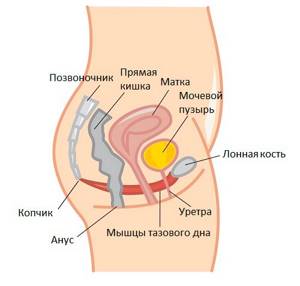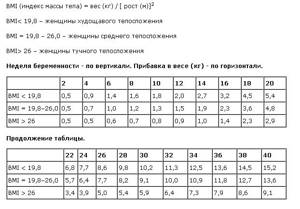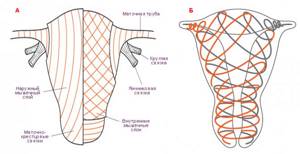At what week of pregnancy does the belly start to grow?
Women in an interesting position are interested in their belly. A new state, a little life inside and many good and not so little things are like a dream. A growing belly is a sure sign of a child’s growth and a signal for a wardrobe update.
Women's tummy growth occurs individually. Most likely, the stories of girlfriends and mothers from forums have led you to a dead end. Some talk about the appearance of such a sign as a rounded belly as early as 5 weeks, and others at 12 or 18. So how to determine when the belly begins to grow during pregnancy?
“Belly growth” may not be due to pregnancy, but rather due to banal overeating and non-compliance with the diet. Talking about growth signaling pregnancy in the first trimester is awkward. This happens from 16 weeks.
Women with a wide pelvis or thin women can show their status by 4-5 months. The second time, many women note that the belly becomes more noticeable earlier than the first time.
Girls who tend to be overweight or athletic women with developed abdominal muscles cannot boast of their position for quite a long time. “Hidden pregnancy” also leaves a woman without an obvious sign.
The belly is growing, but not pregnant. Why fat accumulates in the abdominal area

You need to take your health very seriously in order to get more pleasure from life.
Every representative of the fair sex wants to be slim, and sometimes it happens that a woman plays sports and goes on a diet, but she still fails to lose weight and her stomach begins to grow, as if she were pregnant, although the woman is definitely not pregnant. There are several reasons for this condition.
Reasons why a woman’s belly can grow in the absence of pregnancy Each representative of the fair sex may have her own reasons for abnormal belly growth, but the most important and common ones can be identified:
- problems with intestinal function , and they can be expressed by constipation or, conversely, disorders, and these conditions can replace each other;
- stressful situations can also negatively affect the figure of a representative of the fair sex, as a woman can begin to eat away her grief;
- lack of healthy eating rules in the diet , and this reason is the most common, since if you have an apple body type, then all the extra calories go into the stomach;
- changes in hormonal levels , and here we can note malfunctions of the thyroid gland;
- the belly may appear due to a lack of vitamins and minerals ;
- Smoking, alcohol abuse, and excessive food consumption will lead to a growing belly, and older women are especially prone to this phenomenon;
- after childbirth, a woman needs time for her stomach to return to normal, since the walls of the abdomen are greatly stretched;
- gynecological problems can also provoke abdominal growth, and even with diabetes, fat deposits occur in the abdomen and thighs.
Methods for getting rid of and preventing the appearance of belly fat in women It is best to try to prevent such a problem, but if the belly begins to grow, then it is best to consult a doctor and undergo a comprehensive examination to find out the cause of this phenomenon, and then the doctor will be able to prescribe the appropriate treatment.
Before you go to the doctor, you can try to get rid of this problem yourself, and to do this you need to do the following:
- it is worth getting rid of bad habits;
- organize your diet correctly, without eating junk food;
- You should definitely engage in physical activity, but you should correctly calculate your strength and start with light exercises.
If these steps do not help you get rid of your belly fat, then you should contact a medical facility to receive qualified help.
You need to take your health very seriously in order to get more pleasure from life. Do not forget about walks in the fresh air and avoid stressful situations.
Source: rsute.ru
How does the belly grow during pregnancy?
Several factors influence how the belly grows during pregnancy. The main ones include:
- baby's growth;
- enlarged uterus;
- change in the amount of amniotic fluid.
Attention! Gynecologists note that a visual increase in fat begins at about 16 weeks in most women. This is considered average.
There are several other factors. They also have an important and direct impact:
- First pregnancy. Growth is slow. This is explained by the fact that strong abdominal muscles are difficult to stretch. In the second and subsequent pregnancies, girls notice significant growth earlier. The muscles are already more elastic and stretch easily.
- Heredity. If your mother and grandmother had a baby bump early, you should expect the same for you.
- Anatomy of the body. Thin and slender women can enjoy their position earlier than fat or toned girls.
- By the middle of the term, the position will become noticeable in curvy, tall girls, as well as in those who have wide hips and pelvis.
- Fruit size. The growth of the baby and the stretching of the uterus will change your figure.
- Presentation. It is important to pay attention to how the baby lies. Plays a big role in the appearance of the tummy and the attachment of the placenta. If the attachment was along the back wall of the uterus, then you may not see the long-awaited pregnant belly soon. Presentation along the anterior wall of the uterus makes it more likely to see the main sign of pregnancy earlier.
- Weight gain. If a woman “eats for two,” then her body weight may begin to increase. The belly will only grow from excess fat.
The stomach becomes stone during pregnancy without pain: physiological reasons
Sometimes abdominal tension appears without pain.
A painless course speaks in favor of physiological reasons (which does not at all exclude risks for pregnancy). Factors leading to a hard belly depend on the stage of pregnancy.
In the early stages
In the first trimester, an increase in tone is caused by:
- natural changes in the tissues of the uterus, restructuring of the organ for gestation;
- small uterus, “two-horned”, with a bend;
- lack of progesterone, which is produced by the corpus luteum of the ovaries in the first trimester;
- underdevelopment of the pelvic organs;
- Rh conflict in the blood of mother and fetus;
- severe toxicosis, accompanied by frequent vomiting.
In the early stages, increased uterine tone does not always result in hardening of the abdomen, and the pregnant woman learns about the problem during an examination by an obstetrician-gynecologist or an ultrasound scan. The case may end in miscarriage, so monitoring in the LC is necessary from the first weeks of pregnancy.
In the later stages

In the second and third semester, everything is in sight: a hard stomach is a constant companion of uterine hypertonicity. Physiological discomfort is caused by:
- multiple pregnancy;
- large fruit;
- polyhydramnios;
- staying in one position for a long time, especially sitting;
- tight underwear;
- full bladder;
- untimely bowel movements, flatulence, dyspeptic disorders.
Starting from the 20th week of gestation, a woman’s body prepares for childbirth. At this time, “training” Braxton-Higgs contractions are observed. The so-called false labor causes almost no pain, but leads to hardening of the abdomen.
At any time
Reasons that can have a negative impact throughout the entire period:
- early pregnancy (before 18 years) or late (after 35 years);
- stress, fear;
- unsatisfactory living conditions;
- disturbances in sleep/wake patterns;
- harmful working conditions;
- physical overload;
- sexual arousal, orgasm;
- drinking alcohol, smoking.
Each person has their own pain threshold. Therefore, the absence of pain during abdominal hardening does not always indicate the safety of the manifestations for the course of pregnancy and fetal development.

Although relatively harmless in origin, muscle tension is short-lived and appears immediately after exposure to the catalyst.
Coolant measurement. Why is this necessary?
Surely at subsequent appointments you were puzzled by the fact that the doctor was measuring your stomach again. At the first appointment, a control measurement was made. The doctor will build on this figure in the future and monitor the appearance of “alarm bells.”
Everything is measured with a simple measuring tape. The measurement results are strictly recorded in the pregnancy card. This is how the size of the fetus, its development and other indicators are controlled.
Special tables will help determine the correct course of pregnancy and abnormalities.

What can you see when measuring?
- The doctor will determine the correct development of the fetus, enlargement of the uterus and the normal amount of amniotic fluid.
- The abdomen will show oligohydramnios or polyhydramnios.
- The doctor may suspect an ectopic pregnancy.
- Deviations from the norm may indicate pathologies in the child’s development.
- The gynecologist can make an assumption about the presence of infectious diseases.
- Non-compliance with standards can occur as a result of gestosis and placental insufficiency.
- The specialist may suggest a multiple pregnancy.
Even small deviations from the norm should be carefully examined. Additional tests, examinations and ultrasounds are prescribed.
At what stage does a pregnant belly appear?
The doctor registers the woman at approximately 7-8 weeks. From now on, regular visits to the antenatal clinic and compliance with certain rules are simply necessary.
Each examination begins with measurements of weight, coolant and fundus of the uterus. Indicators are recorded and compared with standards. Even at week 10, the pregnant belly will not be visually visible. But the indicators will talk about its growth and changes.
People around you can see an interesting position with the naked eye closer to 16-18 weeks. At this time, the fetus begins to actively grow. The roundness of the tummy is influenced by the above factors.
Nothing is visible until 12 weeks. The embryo is too small.
In the period from 12 to 16 weeks, only an experienced friend can determine the secret by eye. It is especially good to consider the position if the girl is thin.
Weeks 17-20 can make others aware of your new status. During this time, some clothing becomes tight and uncomfortable. It’s worth thinking about purchasing new comfortable things.
From week 20, the belly grows faster. People around can already see everything and congratulate the expectant mother. Overweight women, as well as those wearing loose clothes, can hide their status.
After 28 weeks, it is simply impossible to hide the situation. Only very plump girls manage to stay in the shadows. During this time, loose or special clothing should be worn.
Pathological causes of stone belly
When pathological factors are involved, a hard belly appears for no apparent reason. This happens quite often, and as the process progresses, pain occurs. In some situations, the uterus is in increased tone most of the time.
Uterine hypertonicity is characterized by a variety of manifestations. There is local tension along the posterior or anterior wall, overstrain of the lower segment of the organ, and a total increase in the tone of the uterine muscles.
The last two options are most often caused by malfunctions in the body and are fraught with serious consequences.
The lower abdomen turns to stone

Starting from the 34th week of pregnancy, a hard abdomen localized in the lower part serves as a harbinger of impending labor. But if the phenomenon is observed from week 20 or even earlier, we can assume:
- exacerbation of chronic inflammation of the pelvic organs (cystitis, colpitis, adnexitis);
- infectious diseases of the genitourinary system (for example, chlamydia);
- the woman “got a cold”;
- presence of tumor processes;
- incorrect position and presentation of the fetus;
- after 28 weeks - dilatation of the cervix and the threat of premature birth.
Fetal sizes at different stages of pregnancy
The first ultrasound makes it possible to find out about the diameter of the fertilized egg. Already in weeks its diameter is 2-4 mm. Next comes the growth of the embryo.
- weeks The embryo is approximately 22 mm in size.
- . CTE is 6-7 cm. Weight fluctuates around 20-25 grams.
- . The CTE reaches 12 cm, and the weight is 100 grams.
- . The height will be up to 26 cm, and the weight will be 300 grams.
- . The size is about 30 cm, and the body weight ranges between 600 and 680 grams.
- . The baby has grown to 35 cm and is approaching 1 kg in weight.
- . At this time, the children grew to 40 cm. The weight was approximately 1.7 kg.
- . Some are already 48 cm long and weigh up to 2.5 kg.
- Before birth, the weight of a full-term baby is from 2.5 to 5 kg. Length ranges from 48 to 54 cm.
About the tummy
Everyone can boast of their unusual position. But everything is individual and ambiguous. Some make themselves and others happy at 4 months, while others hide their situation until 6 or 7 months.
No matter how your tummy grows, it still needs care, or rather its skin. You should not wear tight sweaters and pants, because pressure on the uterus can cause tone and threat. Leave tight and elastic items until better times.
Stretching skin with the growth of the uterus and fetus is prone to the formation of scars and stretch marks. Hormones change the production of collagen and elastin. He is the main one for skin elasticity.
Reddish stripes on the tummy, mammary glands and thighs look unsightly. You can avoid the appearance of stretch marks or minimize their appearance. Use creams or lotions containing vitamins A and E that are labeled “for pregnant women.”
The interesting position of a woman raises many questions. A growing belly is the main visual sign of pregnancy. Curious pregnant ladies are interested in changes within themselves.
A lot of interesting information can be found on the Internet and books. In addition, modern technologies suggest installing a diary application on your smartphone, which will not only tell you about each week of pregnancy in detail, but also give nutritional recommendations and record all the changes that happen to you.
When the belly begins to grow during pregnancy - video
When does the belly begin to grow during pregnancy: at what stage?
5 (100%) voted 1
Symptoms of abdominal swelling
There can be many reasons for this condition, for example, the formation of pathologies, dysfunction of internal organs and physiological reasons.
Symptoms of the development of gestosis:
- Swelling of the lower and upper extremities,
- Puffiness of the oval face,
- Swelling of the anterior abdominal wall,
- High blood pressure,
- Cramps.
Edema during pregnancy occurs due to dysfunction of capillary permeability and disturbances in water-salt balance.
Abdominal edema during pregnancy most often appears in the middle of the second trimester. Swelling is also characteristic of the sacral and lumbar regions. This occurs due to the fact that the level of fluid in the body of a pregnant woman increases. Abdominal edema is one of the most serious, because it is a hidden type that is difficult to diagnose on time.
Swelling of the abdomen during pregnancy is dangerous for the fetus; internal tissues, abdominal muscles, and the uterus swell and the placenta swells. Due to this, the flow of oxygen to the baby is significantly deteriorated, and pregnancy may be in jeopardy.
Possible complications of abdominal swelling:
- Miscarriage,
- Sluggish labor,
- Severe toxicosis,
- placental abruption,
- Fetal anemia, etc.
It is also common to have a premature baby or muscular dystrophy.
To prevent fetal developmental disorders, it is necessary to timely determine abdominal edema during pregnancy; for this, urine tests, blood pressure levels and the weight of the pregnant woman should be monitored from the middle of the second trimester.











